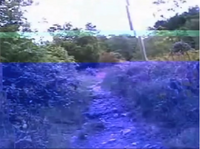Code Mosh
The Museum of Glitch Aesthetics (MOGA) has collected three works of Lake District Walks video series. The series investigate different viewing experiences during The Artist 2.0's time in the isolated location of Lake District of England.[1]
Summary
The three video series displayed at MOGA present a compilation of raw footage, shot from a Nokia N93, with multiple glitch effects produced by a laptop. In particular, Lake District Walks: Code Mosh, portrays the natural hike while combining corrupted data, shown through colourful and flickering lights.[2] The angle and datamoshing exemplify the notion of "moshing" as the lights violently and agressively jump up and down. [3]
| Lake District Walks: Code Mosh | |
|---|---|

| |
| Artist | The Artist 2.0 |
| Medium | Footage from Nokia N93 |
| Date | 2007-2008 |
| URL | http://www.glitchmuseum.com/ldw2.html |
Technical Information
The Lake District Walks series were shot on a mobile phone, Nokia N93, where the “unique swivel design” [4]was entirely utilized to capture the mobility of the adventurous hike. The footage presents an unsettling walk displayed through the variety of angles and lighting captured on the camera along side with the artist’s addition of data moshing in his laptop studio. The Artist 2.0 reveals through the “walkthrough” that the “most natural is now revealed to be nothing more than a stream of corrupted data that disturbs our understanding.”[5]
Critiques
Whitebread questions and analyzes The Artist 2.0’s technical process involved in the execution of the Lake District Walks series. He compares Richard Long’s traditional and aesthetically appealing “walkthrough” in relation to The Artist 2.0.[6] Whitebread believes that The Artist 2.0 abandons “aestheticized documentation” that Long has excelled in his work. Instead, these aesthetic elements are problematic and become an “administrative nuisance”.[7] Whitebread continues as he criticizes The Artist 2.0’s use of technology as he refrains from the natural and traditional methods. “He’ll then take the phone loaded with its video data back into the studio, and by that I mean his laptop— he really is not a studio artist.”[8]
References
- ↑ http://www.glitchmuseum.com/lakedistrictwalks.html
- ↑ http://www.glitchmuseum.com/lakedistrictwalks.html
- ↑ http://www.merriam-webster.com/dictionary/mosh
- ↑ MOGA Catalog, 6
- ↑ MOGA Catalog, 6
- ↑ MOGA Catalog, 6
- ↑ MOGA Catalog, 6
- ↑ MOGA Catalog, 6
Wiki Authors
- Bo Ha